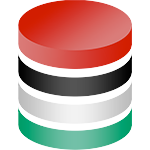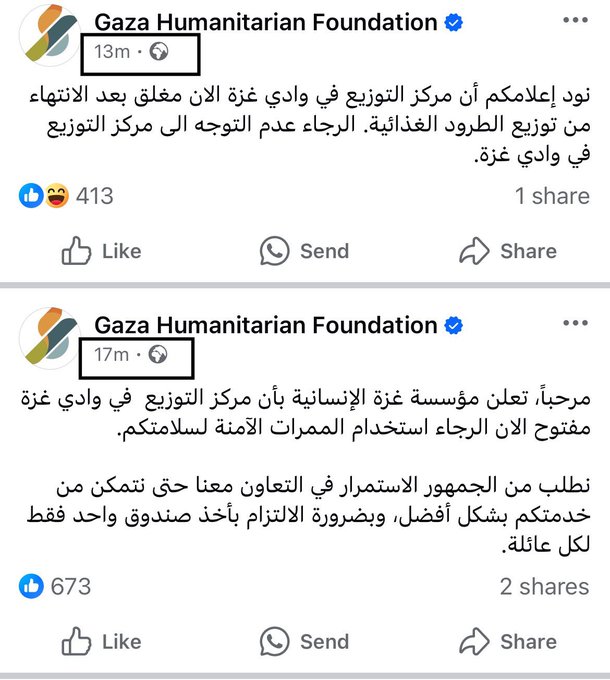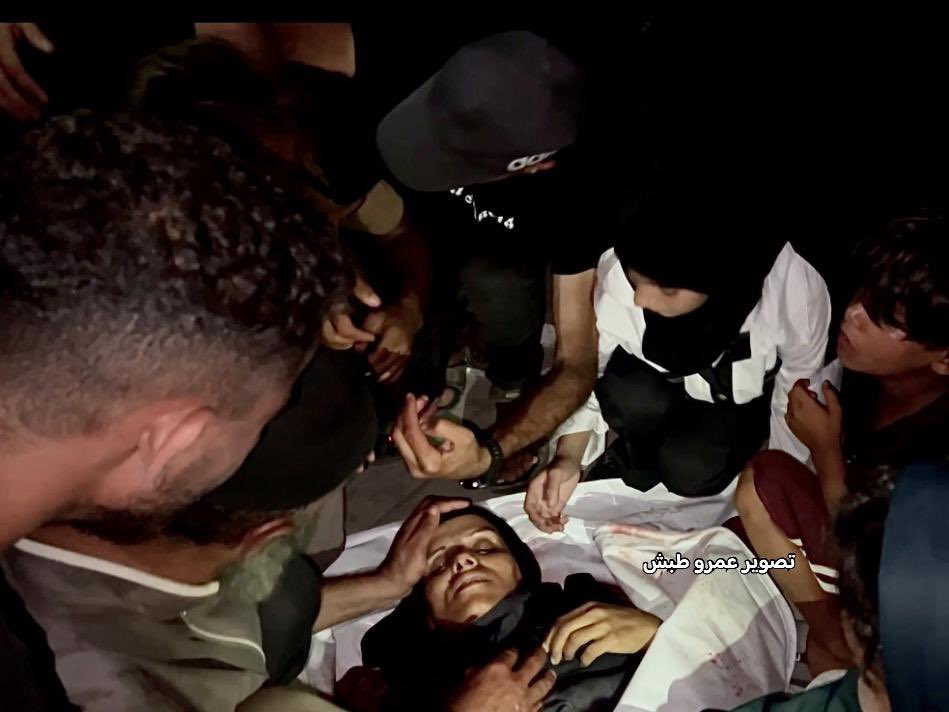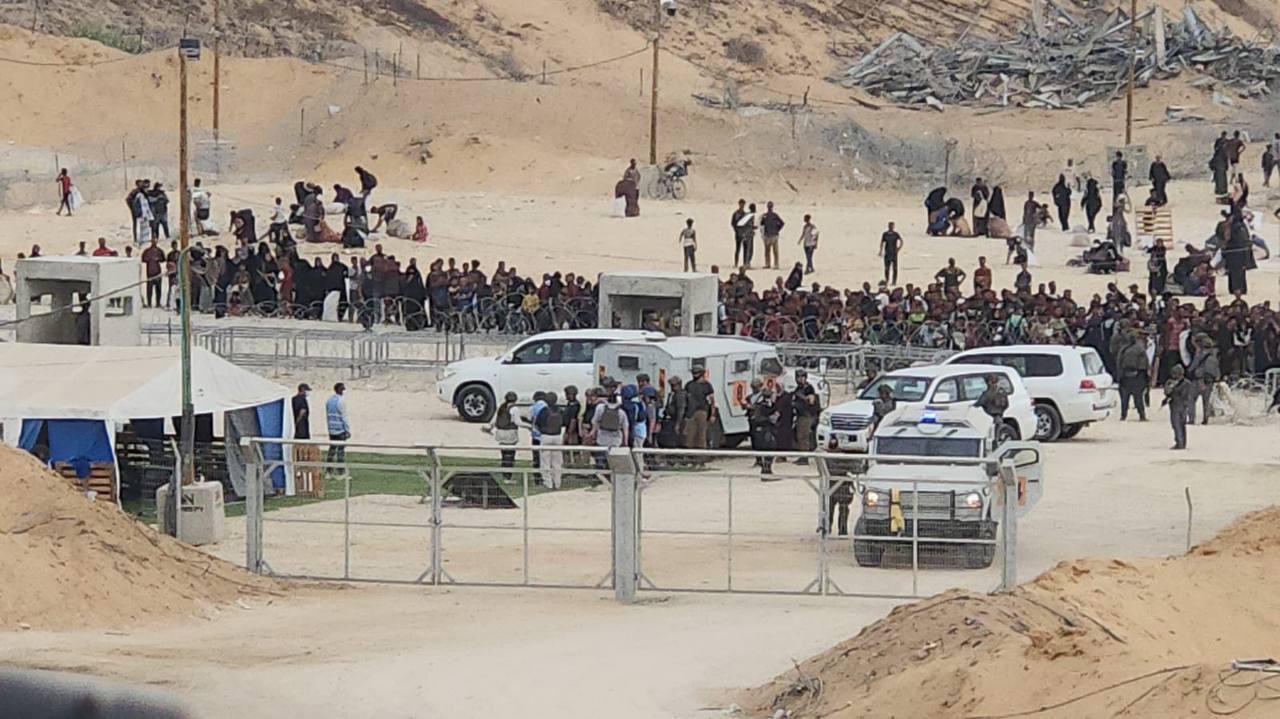
TikTok Genocide

Thousands amass near the Netzarim aid site at midnight
No.
19664Date
11 June, 2025Location
Original Social Media Post
"في الوقت الذي تنام فيه الآن، ينتظر الآلاف من الأهالي قرب محور نتساريم، علّ الجيش الإسرائيلي يسمح لهم بالحصول على المساعدات من مركز المساعدات التابع للمرتزقة الأمريكيين. ومثل كل يوم، سيُقتل العشرات منهم ويُصاب المئات، وتعود الغالبية العظمى إلى عائلاتهم دون طعام ." - Source
Archivist Notes On This Video
"While you sleep now, thousands of families are waiting near the Netzarim corridor, hoping the Israeli army will allow them to receive aid from the center run by American mercenaries. As on every day, dozens of them will be killed, hundreds injured, and the vast majority will return to their families without food."
Event Notes
Gaza Humanitarian Foundation massacresDeveloping. Details included may be subject to adjustments.
The following is a timeline of days on which casualties were reported by local sources. These reports have not been fully verified against the timeline published by the Government Media Office in late June 2025.
May 27:
3 people were killed and 46 injured.
May 28:
10 people were killed, 89 wounded
June 1 dawn massacre
35 people were killed and around 230 wounded by gunshot injuries in the early dawn hours as they were headed a GHF base in Rafah to line up for aid. British surgeon volunteering at Nasser hospital Dr. Victoria Rose confirmed the victims came with gunshot wounds.
June 2:
Since the early morning hours, 26 other Palestinians were killed and 122 injured, all while the IDF denied access to ambulances. Identified victims:
- Ahmad Abdulkarim Hussein Shaheen
- Hasan Nayef Abdullah Abu Mtir
- Muhannad Abdulfattah Muhammad Saad
June 3:
Around 6 am, the IDF opened fire on Palestinians amassing at the GHF base in Rafah. Instead of denying it, this time the IDF, through its stenographers, openly declared "For the third day in a row, the IDF says troops opened fire on Palestinian suspects who approached forces around 500 meters from a humanitarian aid distribution site in the Rafah"
According to investigative journalist Younis Tirawi, the IDF's 646th Brigade, commanded by Colonel Yoni HaCohen, was likely involved in the mass murder. The colonel is the son of Re’em HaCohen, a senior religious settler & head of the Otniel illegal outpost in Al-Khalil/Hebron.
The Ministry of Health confirmed that 27 people were killed and over 120 injured. The martyrs include:
- Khaled Ahmad Mohammad Abu Suwailem
- Abdullah Shadi Jawad Salah
- Ibrahim Iyad Khamis Dahliz
- Adnan Abdurazzaq Abu Harb
- Fouad Shaker Diab Al-Ghannam
- Abdullah Younis Fouad Al-Ghannam
- Laila Abdullatif Sheikh Khalil
- Muhammad Ahmad Hasan al-Shaqaqi
- Muhammad Muhammad Jibril Abu Libda
- Mahmoud Marwan Ahmad Al-Nahhal
- Reem Salama Nasrallah Al-Akhras
- Haitham Jabr Ismail Juma
- Basel Muhammad Shaaban Abu Alwan
- Kamal Arafat Abdullah Al-Nadi
- Ibrahim Khaled Ibrahim Abu Zarqa
- Hassan Ali Hassan al-Banna
- Ismail Jihad Samir Al-Qunn
- Muhammad Suleiman Abdulkarim Sheikh Eid
- Nader Adel Helmi Shaat
- Abdurahman Wissam Fakhri Al-Qadra
- Hala Ismail Salama Al-Mashoukhi
- Ulfat Fawzi Borhom Siam / Zo’rob
- Faiza Suleiman Hussein Al-Hamidi
- Baraa Hani Ahmad Abu Zanad
- Mahmoud Muhammad Mahmoud Shaheen
- Muhammad Muhammad Muhammad al-Najjar
- Tayseer Salem Abdullah Abu Mustafa
- Tayseer Qandeel Abdullah Abu Mustafa
- Rasmi Ibrahim Abdullah Abu Mustafa
- Muhammad Asaad Mahmoud Abu Mustafa
- Hamza Hani Muhammad Asaliyah
- Salim Isaid Salim Abdeen
- Muhammad Akram Mutlaq Al-Dahoudi
- Mahmoud Ahmad Radwan Abu Shaar
June 4:
Starting midnight, civilians started to gather at the site in Netzarim to increase their chances of securing food.

June 6:
I addition to 142 injuries, 8 Palestinians were killed, among them:
- Suhail Hamza Qwaider
- Ibrahim Muhammad Abu Samhan
- Hamza Iyad Al-Jamal
- Muhammad Ibrahim Al-Munirawi
- Samir Awda Al-Nahhal
June 7:
Early morning, 8 Palestinians were killed in one of the sites in Rafah:
- Saeb Hamad Abu Sawawin
- Youssef Adel Abbas Khawaja
- Yasser Abdullah Nasr-ul-Din Kahil
- Nawal Khader Hassan Abu Shab
- Youssef Khader Hasan Abu Shab
- Muhammad al-Abd Azara al-Qar'an
- Iyad Salman Abu Jiyab
- Muadh Mahmoud Al-Qatran
June 8:
Footage from the ground revealed that several casualties from gunfire at both the Netzarim site and the site near the Fish Fresh area west of Rafah. Among the victims of the latter was Khaled al-Daghma, a father of five who earned his living by transporting aid seekers on his donkey cart to and from the GHF site.
June 9:
At least 14 people were confirmed killed at the site in Al-Alam area west of Rafah:
- Suhaib Awadallah Abu Ouda
- Saeed Hani Fadi Al-Attar (17 y/o, came from Beit Hanoun in North Gaza)
- Omar Mohammad Salam Siam
- Bassam Abdullah Abdurahman Awad
- Mohammad Atta Saleh Ayoush
- Omar Mohammad Fathi Abu Ouda
- Nader Salim Al-Bayouk
- Mohammad Hussein Ismail Khreis
- Hanan Ali Abu Shanar (female)
- Ihab Yusuf Mahmoud Abu Rumi
- Ahmad Saleh Jarmi Al-Tarabin
- Ahmad Muhammad Hasan Awad Al-Najjar
- Yahya Mos'id Mansour Al-Zamli
- Muhammad Khalil Abdurahman Saleh
Dr. Izzeddin Shaheen who works in central Gaza reported that Al-Awda hospital received over 60 injuries from the aid site, refering to the one in Netzarim. As of 4 am, all the aid at Netzarim had already been taken, leaving most aid seekers empty-handed.
Dr. Shaheen shared his experience with one of the injured men from Netzarim. The person needed to undergo surgery but asked if he could be discharged the same day as he was the only provider for his disabled child after the child's mother was killed.
According to journalists on the ground, the shooting and killing have become a daily occurence.
The new development was that footage emerged showing the participation of armed members of the Yasser Abu Shabab looting gang that is endorsed by the IDF and the Israeli cabinet. The gang was seen opening fire at crowds lining up to receive aid from the GHF site.
June 10:
Around 20 Palestinians were killed at Al-Nabulsi roundabout near the Neztzarim site. Footage on the ground documented the deployment of artillery shelling.
In addition, 8 were killed in Rafah.
June 11:
20 killed at the Netzarim site. 13 other were killed in Rafah:
- Yazan Muhammad Abu Amra
- Khaled Mahmoud Al-Majaida
- Yusuf Muhammad Al-Najjar
- Tariq Sameer Al-Tahrawi
- Ihab Yusu Al-Salout
- Rashad Atta Al-Qassas
- Rifaat Shaaban Awad Al-Bash'hiqi
- Ghazal Iyad Ismail Al-Farmawi
- Ibrahim Muhammad Ahmad Lafi
- Rafiq Muhammad Jabr Tayeh
- Ibrahim Asaad Suleiman Baraka
- Muhammad Talaat Abu Salima
- Muhammad Husam Al-Abed
- Mahmoud Ahmad Al-Sadoudi
June 12:
The Ministry of Health had announced that the cumulative death toll of aid seekers at GHF sites reached 245 killed and 2,152 injuries.
13 killed and 170 injured at the Netzarim site. According to local journalists, the casualties were caused by drones dropping grenades and gunfire towards the crowds.
In Rafah, at least 10 people were killed:
- Qasem Abu Rahila
- Saadia ABu Nahla
- Yahya Ibrahim Al-Habibi
- Saleh Ashraf Abu Tuaima
- Muhammad Marwan Mohareb
- Moayed Imaduddin Al-Sarsak
- Muhammad Anwar Al-Nahhal
- Muhammad Nahed Dababesh
- Muhammad Saleh Al-Madani
- Rajab Sabri Abu Sultan
June 14:
At midnight, Israeli drones opened fire on crowds gathered to wait for aid distribution in northeast Nuseirat, leading to 15 people being killed and dozens of injuries.
Identified victims:
- Hadi Saadi Abu Taha
- Yusuf Muhammad Al-Mudallal
- Watan Mahmoud Al-Tantawi
- Bassam Abu Isha
- Sobhi Al-Atawna
- Abdullah Al-Batran
June 15
At least 3 Palestinians killed near the Netzarim site. In Rafah, 10 were killed and more than 50 injured.
The Ministry of Health announced the death toll at these aid sites had reached 300 killed and 2,649 injuries.
Identified victims:
- Mahmoud Hassan Mohammad Darwish
- Sobhi Muhammad Sobhi Al-Shaer
- Fatima Ismail Wasfi Al-Faqaawi
- Muhannad Hassan Musa Musa
- Khalil Hatem Khalil Badwan
- Fouad Hussam Ahmzd Abu Matroud
- Ibrahim Al-Khatib
- Nour-El-Din Khalil Salman Mukhaimer
- Ahmad Kamel Ahmad Al-Ghalban
- Mahmoud Mohammad Abu Habib
June 16:
28 people were killed and 200 injured in Rafah:
- Youssef Nidal Othman
- Abdullah Hamouda Abu Haleeb
- Rashid Mohammad Zo'rob (child)
- Mahmoud Mohammad Al-Maghribi
- Alaa Shafiq Al-Khatib
- Ismail Khaled Dabour
- Mohammad Omar Al-Sinwar
- Saleh Abdulqader Abu Suleiman
- Zakaria Dawoud Abdu-ul-Aal
- Muhammad Marwan Al-Kafarna
- Sharif Khalil Ghureiz
- Atallah Fathi Shatat
- Mohammad Ahmad Al-Sawalha
- Waseem Mohammad Al-Zain
- Rami Misbah Abu Qura
- Saif al-Din Muhammad Zo'rob (child)
- Ali Youssef Jadallah
- Hussein Ali Al-Saqqa
- Muhammad Ibrahim Abu Khammash
- Abdusalam Atef Abu Azoum
- Mohammad Raed Al-Yaziji
- Samer Aseed Rmilat
- Nour-El-Din Mohammad Bouzia
- Ahmad Samir Al-Jabali
- Abdullah Muhammad Abed
- Muhammad Masoud Sheikh Al-Eid
- Abdurahman Nidal Shaheen
- Moamen Raed Arafat
June 18:
Early morning, 11 people were killed and over 70 injures at the Netzarim site. At least 5 people were killed at the Rafah sites:
- Ahmad Ibrahim Muhammad Qishta
- Ibrahim Ahmad Muhammad Abu Rizq
- Karam Mustafa Abu Zaid Al-Majaida
- Hisham Faisal Hasan Musa
- Muhammad Tawfiq Suleiman Abu Hasanein
June 20:
At pre-dawn hours, around 23 people were killed and taken to Al-Awda hospital after being shot at the Netzarim site. In addition, at least 11 were killed while seeking aid in the southern governorates:
- Imran Muhammad Abdulkarim Abu Shakyan
- Huzaa' Muhannad Husam Al-Qadi
- Hamza Adib Iyada Al-Sarsak
- Khaled Husam Khaled Al-Kilani
- Wisam Mahmoud Ismail Bakir
- Muhammad Mahmoud Yusuf Baraka
- Imad Ihab Ibrahim Zinoun
- Najlaa Fathi Ahmad Al-Qadi
- Ulfat Yusuf Muhammad Othman
- Sami Jamal Al-Badi
- Hussein Khalil Hussein Al-Souri
June 21:
At least 11 people were killed at aid sites, including:
- Saeed Riad Saeed Al-Ghandour
- Amjad Sami Salim Abu Safra
- Hamada Khalil Muhammad Slayem
- Jawad Fathi Jawad Al-Zard
- Muhammad Atef Yusuf Zo'rob
- Youssef Ahmad Shaker Abu Youssef
- Najah Sabri Ismail Abu Arar
- Muhammad Samir Hassan Al-Kahlout
- Abd Awni Muhammad al-Namnam
- Osama Nazmi Hamdan Qudaih
- Azmi Yahya Muhammad Abu Jaber
June 24:
Around 2 am, aid seekers gathered on Salah al-Din Street near the Netzarim site were targeted, killing 22 people
June 27:
Around midnight, the GHF facebook page announced the opening of the distribution point only to announce closing it within 4 minutes after "finishing the distirbution of food parcels."
At least 6 Palestinians were killed near the Rafah aid sites
- Muhammad Ahmad
- Ahmad Al-Aqqad
- Abdullah Abu Hamad
- Muhammad Saad Tabasi
- Mahmoud Muhammad Hasan
- Salah Misbah Tabasi
June 28:
At least 6 people were killed near Rafah sites:
- Momen Sobhi Mahmoud Arandas
- Haitham Adel Farid Abu Sitta
- Abdulbasit Abdurahman Juma Al-Hams
- Thaer Mohammad Hamed Al-Lull
- Ammar Yasser Ismail Al-Zinati
- Nidal Sobhi Baraka Abu Sabla
June 29:
At least 5 aid seekers were killed at Al-Shakoush near the SDS2 site in the Saudi neighborhood in Rafah:
- Muhammad Muhammad Abu Mustafa
- Bilal Muhammad Nabil Abdulghafour
- Ahmad Rouhi Al-Jazzar
- Ahmad Yusuf Al-Astal
- Hamza Raafat Abdullah Al-Qatati
June 30:
13 aid seekers were killed on Al-Teena Street, southwest of Khan Younis:
- Ibrahim Suleiman Sheikh Al-Eid
- Khaled Jamal Al-Satri
- Rakan Riyad Ateesh Abu Omra
- Uday Suleiman Abu Jazar
- Ahmad Isam Mahmoud Al-Shana
- Mohammad Naji Mahmoud Al-Shana
- Ahmad Mohammad Morshed Al-Qadi
July 1:
The Ministry of Health updated the death toll from what it called the "aid death traps" to 583 killed, including 408 specifically at GHF sites, and 175 killed while waiting for aid entry.
At least 6 people were killed at Rafah sites:
- Yasser Adel Al-Shaer
- Mohammad Sami Ibrahim Abu Mustafa
- Ahmad Marwan Mohammad Sarhan
- Khaled Wael Mohammad Alwan
- Fayez Hilal Zanoun
- Abdulkarim Jamal Abu Hadaid
Close to midnight, the GHF announced on social media that its Netzarim site would not open until 2 am. 
July 2:
At least 5 people were killed at Rafah sites:
- Ahmad Abdurahman Ahmad Khattab
- Abdullah Ashraf Ahmad Abu Hilal
- Ramzi Riad Ramadan Al-Jabri
- Saeed Ziyad Subhi Al-Faqawi
- Sami Akram Abdullah Al-Rakhawi
July 3:
30 people were killed at the Netzarim site.
July 4:
Around 8 pm, aid seekers were killed near the Netzarim site, including four children:
- Ibrahim Abdullatif (child)
- Muhammad Zuhayr Musa Abu Ariban (14 y/o)
- Mahmoud Hasan Miqdad (15 y/o)
- Akram Tariq Salem Al-Masalha (12 y/o)
July 5:
9 aid seekers were killed in Rafah including three children:
- Mohammad Ahed Yasser Hamad
- Nidal Akram Mohammad Al-Hou
- Moamen Mohammad Abd-Rabbo Al-Qar'an
- Abdullah Alaa Youssef Al-Khatib
- Salah Ghassan Riyad Al-Qadra
- Jamal Ahmad Jamal Abu Luli
- Alaa Zaki Kamel Al-Rashid
- Ihab Mousa Mohammed Al-Jabour
- Ubaida Kamel Saleem Helles
July 7:
At least three people were killed near the GHF site in northern Rafah:
- Raafat Aql
- Islam Abu Shab
- unidentified
July 11:
10 aid seekers killed and around 60 injured at Al-Shakoush near the SDS2 site in the Saudi neighborhood in Rafah:
- Mahmoud Nabil Al-Kadhimi
- Ahmad Saeed Hammouda
- Ahmad Sidqi Sheikh Al-Eid
- Hamed Jamil Al-Najjar
July 12:
Early morning local reports idnicated that 180 aid seekers were injured and 27 other killed by Israeli gunfire at site in Al-Shakoush area (SDS2) in Rafah.
- Mustafa Sobhi Atiya Arafat
- Sameh Mahmoud Khamis Jarad
- Ahmad Iyad Ahmed Asfour
- Muhammad Tariq Adel Abu Taiba
- Jihad Muhammad Ali Jarghoun
- Mamdouh Adnan Mahmoud Abu Ayya
- Nasser-Al-Din Suleiman Hamdan Al-Shaer
- Mahmoud Muhammad Hamdi Al-Zaytouni
- Ali Khaled Abu Ayyash
- Muhammad Wiam Qasim Al-Aqraa
- Ali Khaled Abu Ayyash
- Muhammad Wiam Qasem Al-Aqraa
- Mahran Salem Sobhi Shabir
- Muhammad Khaled Hassan Al-Qarinawi
- Youssef Adel Ahed Al-Bouji
- Ahmad Mazen Mahmoud Al-Buraim
- Firas Osama Abdulamid Fojo
- Wael Tawfiq Suleiman Al-Aqraa
- Firas Ramzi Muhammad Al-Mashharawi
- Mahmoud Hassan Muhammad Al-Louqa
- Ahmad Muhammad Ismail Lubbad
- Ahmad Namir Ahmad Shaqoura
- Muhammad Yunis Hussein Taha
- Hasan Hammouda Hasan Abu Jarad
- Al-Moatasim-Billah hasan Mahmoud Al-Habbash
July 13
At least three aid seekers were killed at the Rafah site near Al-Shakoush area (SDS2):
- Muhammad Ahmad Al-Najjar
- Fayeq Jumua Hajjaj
- Muhammad Ahmad Abu Jazar
July 14
At least three aid seekers were killed at the Rafah site near Al-Shakoush area (SDS2):
- Nasrullah Salah Nasrullah Al-Qadra
- Rami Ahmad Ali Al-Shaafi
- Ahmad Abd Hamdan Abu Darb
July 15
At least 2 women were killed a a site north of Rafah.
- Rania Mahmoud Awad Abu Tuaima
- Widad Ibrahim Abdullah Sheikh Al-Eid
In the evening, at least two men were killed at the site in Al-Alam area in Mawasi Rafah.
- Ahmad Ayman Ahmad Abu Jazar
- Amro Hani Ismail Abu Muteir
At Netzarim, 26 year-old Muhammad Marwan Al-Najdi was killed by gunfire.
A pediatrician reported receiving 15 cases of food poisoning caused by beans distributed among "American food aid packages"
July 16:
9 aid seekers were killed on Al-Teena Street southwest of Khan Younis.
In addition, early morning 21 aid seekers were killed at southern Gaza GHF sites, including 6 by gunfire, while 15 others died from suffocation after soldiers and mercenaries threw gas canisters into a densely crowded tight space according to eyewitness testimonies. The accoutns also shared that some of the deaths may have been due to the ensuing stampede in the confined space.
- Yasser Hasan Salman Al-Malaha
- Saqr Wael Ibrahim Al-Batniji
- Firas Fares Izzat Abu Jami'
- Firas Ali Hasan Al-Tahrawi
- Walid Muhammad Abdulaziz Dahir
- Mahmoud Muhammad Salha
- Anas Narsallah Al-Tarabin
- Jihad Fathi Marzouq Al-Najjar
- Karam Ismail Hasan Al-Nawajha
- Mohammad Mahmoud Muhammad Abu Maarouf
- Thaer Mar'i Muhammad Al-Attar
- Mohammad Yaser Rizq Abu Amra
- Yazan Ayman Shahda Abu Shab
- Alaa Maher Khalil Taha
- Zyad Muhammad Hilmi Barbakh
- Muhammad Ayman Ahmad Ruqa
- Ubaida Nabil Faruq Al-Jabri
- Maryam Hamed Muhammad Abu Khatla
- Mahmoud Nidal Ayesh Al-Agha
- Ahmad Mahmoud Ubaid Mohareb
- Yaser Jihad Salem Jadallah
In the evening, Israeli artillery targeted aid seekers near the Netzarim site leading to at least four deaths:
- Muhammad Ghayad Abu Slayeh
- Hamza Abu Huweishel
- Amro Mohsen Abu Huweishel
- Muhammad Kamal Al-Qashtan
July 18:
At least 3 aid seekers were killed near the Netzarim site
- Yusuf Muhammad Totah
- Alaa Yaqoub Al-Bahisi
- Faris Jaber
July 19:
32 aid seekers were reported killed around the site near Al-Teena Street southwest of Khan Younis.
- Sabri Montaser Sabri Jadallah
- Ibrahim Sabry Ibrahim Al-Arja
- Muhammad Faraj Saleh Abu Anza
- Hussein Hassan Musa Dabour
- Mahmoud Muhammad Ahmad Zo'rob
- Amr Rohi Abdulqader Abu Riash
- Mahmoud Arif Ragheb Abu Muammar
- Rasel Atallah Abdulwahid Abu Athrah
- Haidar Ali Ahmad Othman
- Ahmad Rafiq Muhammad Abu Habib
- Hisham Munther Khader Fasifes (child)
- Rafiq Ayman Rafiq Sammour
- Khalil Salah Abdulfattah Abu Shawish
- Khamis Samir Muhammad Khalil
- Abdullah Ahmad Samir Abu Amsha
- Ali Fayez Ali Abu Abed
- Hassan Amin Muhammad Hammad
- Fayez Jamal Ahmad Abu Akr
- Abdullah Fathi Hamdan Al-Dabari
- Musa Haidar Musa Al-Darbi
- Hossam Samih Salim Qudeih
- Naim Hamdi Ahmad Al-Masri
- Muhammad Fuad Muhammad Tuman
- Ahmad Naim Abdulmajeed Kallab
- Muawiya Fawzi Suleiman Al-Kahlout
- Abdulmalik Shaaban Al-Qarm
- Sameh Suhail Atta Abu Shab
- Sohaib Zayed Hamdi Abu Mashi
- Salsabil Shamikh Hindi Al-Qadi
- Muhammad Mmuhammad Kamal Abu Ajwa
In addition, at least 4 aid seekers were killed near the netzarim site:
- Abdullah Misbah Al-Hourani
- Isa Ahmad Al-Kafarna
- Iyad Talal Al-Samouni
- Muhammad Rajab Jaras
In the evening, a child was killed while attempting to head to the closed Netzarim site which was closed.
- Ibrahim Mahmoud Abu Roq'a
July 20:
Early morning, nine aid seekers were killed near sites around Al-Shakoush area (SDS2) and Al-Teena Street respectively
- Raed Ahmad Jamil Al-Sanadi
- Raed Jamal Abu Zayd
- Yusuf Izz-el-Din Zo'rob
- Ayoub Taleb Al-Malaha
- Bilal Muhammad Al-Lahham
- Luay Rami Abu Al-Rous
- Hasan Khaled Abu Dabusa
- Muhammad Husam-al-Din Al-Hams
- Hasan Muhammad Abu Alwan
July 22:
At least 4 aid seekers were killed near the sites at Al-Shakoush area in Rafah (SDS2):
- Amer Sami Al-Suweirki
- Muhammad Mazen Basla
Four others were killed at Netzarim:
- Khaled Muhammad Al-Hila
- Muhammad GHazi Badwan
- Mahmoud Nahed Al-Qatsh
- Yahya Zakariya Eid
July 23:
The GHF announced on social media dedicating aid distribution on July 24 to women.
Six aid seekers were killed at the Netzarim site. Another three aid seekers were killed near the site north of Rafah:
- Ahmad Abdulkarim Jarad
- Ahmad Fayz Abu Ouda
- Mahmoud Al-Tawil
July 24:
A women-only aid distribution day. A multitude of testimonies of women on the premises corroborated that most of the women returned empty-handed, were pepper sprayed, humiliated and even beaten. Moreover, GHF security troops killed two women:
- Khadija Muhammad Abu Anza (45 y/o)
- Maria Ahmad Muhammad al-Eid, a mother of seven.
On the same day, several teens were released from Israeli torture camps after they were abducted at the GHF site in the Al-Shakhoush area, north of Rafah. The minors, whose ages ranged between 14 and 18, provided testimony of brutal treatment in Israeli captivity. This included beatings, electric shocks, stress positions, sleep deprivation, stun grenades thrown into their cells, starvation, denyinh medication,
The names of the released minors include:
- Imad Mustafa Mohammad Abu Tuaima
- Mahmoud Issam Mahmoud Abu Hadaid
- Moamen Hani Abdulaziz Abu Hajras
- Hilal Ibrahim Mansour Al-Bishti
- Karam Hamdi Abdulrahman Hussein
- Fares Suleiman Saleh Abu Jazar
- Qusay Kayed Tawfiq Al-Zaza
- Ahmad Mohammad Fadl Al-Helou
- Moath Sayed Salem
- Omar Nizar Asfour
July 25:
At least four aid seekers were killed near southern Gaza sites:
- Alaa Hasan Al-Sawarka
- Salah Ali Mahanna
- Abdulaziz Ahmad Abu Zubayda
- Khitam Salem Abu Musa
July 26:
At least three people were killed near the Netzarim site.
In addition, Civil Defense crews recovered the bodies of 12 aid seekers killed around the Morag axis south of Khan Younis, including:
- Hamad Muhammad Hamad Abu Taha
- Imad Khalil Al-Majayda
- Kamel Fouad Muhammad Barika
- Hani Jamil Tawfiq Shaqir
- Salim Abdurahman Salim Sharrab
- Khaled Yaser Yunus Al-Hallaq
- Yasin Hani Abdurahman Abdulwahab
- Khader Ahmad Muhammad Abu Sultan
- Ahmad Ibrahim Ismail Al-Bardini
July 27:
Despite Israel announcing "humanitarian pauses" to "improve the humanitarian response in Gaza", it continued massacring aid seekers. Notably, footage from the ground documented chaos at Wadi Gaza (Netzarim) and bodies of young Palestinians gunned down. 11 aid seekers were reported killed near the Netzarim site.
- Fidaa Ata Saad
- Fouad Abu Jabal
- Ata Abdusalam
- Bassam Abdusalam
- Ramadan bdurahman Abdulhadi
- Abdullah Ramzi Karam Miqdas
According to Drop Site News, "Al-Awda Hospital in Nuseirat received 13 bodies, including 4 children and a woman, and 113 wounded after Israeli forces opened fire near the GHF aid point on Salah al-Din Street in central Gaza. Al-Aqsa [Martyrs] Hospital treated victims with cluster of head and eye injuries from the same incident. 5 were brought dead and over 200 injuries. The pattern echoes what British surgeon Nick Maynard previously described as a “game” Israeli soldiers play, targeting different body parts of Palestinians on different days."
July 28:
Early morning, at least six people were killed and around 20 injured near the Netzarim site.
- Ahmad Hazem Al-Moghanni
- Yusuf Raed Nofal
- Ahmad Jamil Al-Ghoul
- Saleh Azmi Abu Shamala
- Mustafa Raed Al-Ustadh
- Moataz Hasan Abu Abda
July 29:
At least four aid seekers were killed at Al-Shakoush area (SDS2) of Rafah.
15 other aid seekers were killed in Netzarim.
July 30:
At least four aid seekers, including a child, were killed near the Netzarim site.
25 other aid seekers were killed near the site around the Morag corridor in Rafah.
July 31:
12 aid seekers were killed and 65 injured near the Netzarim site:
- Mustafa Jamil Al-Hour
- Amir Bilal Al-Ashram
- Mohammad Thabet
- Mohammad Ahmad Ayad
- Muad Al-Sarsak
- Mohammad Ahmad Al-Jaidi
- Mohammad Ramzi Alyan
- Ahmad Marwan Saleh
- Alaa Kamal Al-Zayan
- Mohammad Nabil Ibrahim Al-Qarinawi
In Rafah, at least four were killed in Al-Shakoush area (SDS2):
- Baraa Momen Muhammad Nassar
- Misbah Mahmoud Abed Abdul-Aal
- Tahrir Ata Alyan Abu Wadi
August 1:
US President's special envoy Steve Witkoff visited a GHF site in Rafah. The IDF used the opportunity to stage and film more orderly and restrained footage from the site without repressing or firing upon the aid seekers.
August 3:
Early morning, 9 people were killed near GHF sites in Rafah.
In the afternoon, 7 others were killed at the Morag corridor.
August 4:
A number of aid seekers were killed in Rafah, including 28 year-old Abdulmajid Adnan Salama a volunteer with the Palestine Red Crescent in Khan Younis for the past seven years. The PRCS officially confirmed he was killed while seeking aid at a GHF site west of Rafah.
August 5:
Several aid seekers were killed on Al-Tina Street
- Ahmad Suleiman Al-Namilat
- Abdurahman Ayman Musabbah
- Muhammad Musa Abu Nasira
- Ubaida Fayez Banar
- Nabil Suleiman Al-Majayda
- Hani Nawaf Al-Qufaidi
- Ahmad Khader Abbas
August 6:
The cumulative death toll of aid seeker massacres, combining GHF massacres and those on aid convoy routes across other areas of Gaza, reached 1,655 killed and 11,800 injured.
5 people were killed near the Netzarim site, 10 in Rafah in the morning
- Mahmoud Muhammad Tabaza (Netzarim, morning)
- Muhammad Abdulhamid Muhammad Abu Hasna (58 y/o, Netzarim)
- Muhammad Muhammad Abdulhamid Abu Hasna (28 y/o, Netzarim)
- Mahmoud Abdulhamid Muhammad Abu Hasna (17 y/o, Netzarim)
- Yusuf Muhammad Abdulhamid Abu Hasna (35 y/o, Netzarim)
- Ahmad Abdurazzaq Al-Abadla (Morag)
August 7:
At least 2 people were killed and over 30 injured in Al-Shakoush area (SDS2), and another in Morag
- Malak Ahmad Abu Qatta (20 y/o)
- Sufyan Muhammad Saleh
August 8:
3 aid seekers and 12 injured killed near the Netzarim site.
- Mohammad Walid Tabaza (35 y/o)
- Saif Bilal Abu Ouda (19 y/o)
- Muad Alaa Al-Hawajiri
August 10:
AT least 13 aid seekers were killed across the southern sites:
- Muhammad Imad Muhammad Al-Harazin (Al-Tina)
- Tarek Usmail Muhammad Abu Musa (Al-Tina)
- Saed Jamal Bashir Al-Boji (Al-Tina)
- Ihlil Akram Abdulfattah Abu Sanima (Al-Tina)
- Muhammad Raed Saeed Mansour (Al-Tina)
- Ismail Atta Atiya Al-Najjar (Morag)
- Fadi Khalil Muhammad Isleem (Morag)
- Zyad Suleiman Muhammad Abu Asi (Morag)
- Ahmad Muhammad Nassar Abu Sitta (Morag)
- Ahmad Mansour Ahman Mansour (Morag)
- Abdurahman Azmi Abdurahman Zaidan (Morag)
- Muhammad Jamal Ahmad Awad (Morag)
- Abdurahman Salman (Shakoush)
August 12:
The cumulative death toll of aid seeker massacres, combining GHF massacres and those on aid convoy routes across other areas of Gaza, reached 1,838 killed and 13,409 injured.
August 13:
AT least 14 aid seekers killed in southern Gaza
- Muhannad Hasan Hammad Al-Attar
- Mohammad Awadallah Abu Nahl
- Salah Mohammad Salah Huneideq
- Hamza Khairi Mohammad Abu Saud
- Rabhi Mahmoud Suleiman Baraka
- Mohammad Majdi Salem Abdul-Aal
- Ahmad Hazem Khalil Tabash
- Mohammad Mahmoud Mohammad Abu Amer
- Bahaa Khalil Mohammad Al-Buraim
- Alaa Abdulmohsen Abdul-moneim Abu Said
- Yusuf Jamal Muhammad Al-Najjar
- Yusuf Bahij Deeb Al-Hams
- Yusuf Mahmoud Al-Abd Al-Jourani
- Suleiman Mdhat Suleiman Al-Abed
August 17:
Over 30 aid seekers were killed across GHF sites in southern Gaza:
- Amir Ayman Marzouq Abu Khater (Morag)
- Abdul-raouf Moqbil Khattab Breikh (Morag)
- Imran Nasrullah Atallah Al-Hamsi (Morag)
- Shaher Maysara Ata Hassan (Morag)
- Muhammad Hasan Ghannam Abu 'Araj (Morag)
- Ahmad Hamed Farraj Abu Shanab (Morag)
- Iyad Hasan Salmi Abu Qablan (Morag)
- Rayan Sami Hasan Abu Iyada (Morag)
- Yusuf Nadmi Ibrahim Abu Hammad (Morag)
- Naser Karam Kamel Abu Hamid (Morag)
- Osama Al-Shaer (Morag)
- Wisam Sufyan Abdulhay Abd-Rabbo (Morag)
- Suleiman Mahmoud Eid Qudeih (Morag)
- Jihad Salah Suleiman Al-Jarjawi (Morag)
- Aya Muhammad Hudeihed (Morag)
- Mahmoud Hasan Musa Al-Sarr (Morag)
- Firas Muhammad Tawfiq Al-Aqqad (Morag)
- Husein Walid Husein Abu Saada (Morag)
- Isa Nahed Salim Al-Naffar (Morag)
- Tawfiq Shalouf (Morag)
- Aman Musa Diyab Al-Agha (Shakoush)
- Ahmad Fahd Muhammad Qishta (Shakoush)
- Ilham Muhammad Abdulhalim Al-Mughayer (Shakoush)
- Ali Muhammad Ali Al-Satri (Al-Tina)
- Saleh Akram Saleh Al-Skafi (Al-Tina)
- Alaa Fayez Ali Abed (Al-Tina)
- Muhammad Farhan Dayfullah Khudeir (Al-Tina)
- Abdurahim Hamad Shariqi Sultan (Al-Tina)
- Ali Muhammad Ali Abu Hamda (Al-Tina)
- unidentified (Morag)
- unidentified (Morag)
- unidentified (Morag)
- unidentified (Morag)
- unidentified (Morag)
- unidentified (Morag)
August 19:
At least 5 people were killed across southern Gaza sites
- Mohammad Salama Abdullah Al-Ubaid (Al-Tina)
- Suleiman Musa Suleiman Abu Safra (Al-Tina)
- Ihab Saeed Musa Abu Jazar (Morag)
- Muhammad Sami Khalil Al-Jazzar (Morag)
- Bakr Fathi Abdurahman Al-Najjar (Morag)
August 30:
5 aid seekrs were killed in Netzarim:
- Imad Mustafa Muhammad Zaqout
- Taha Mustafa Muhammad Zaqout
- Imad Hussein Atiya Al-Sori
- Khader Raed Saudan
The details for each video come from social media. None of it has been verified.


